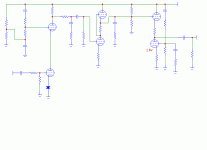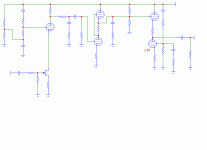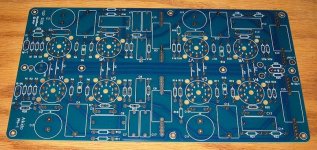john broskie has done a little more than ellude to this. basically you will need two aikido stages with the riaa correction between the stages. 5687 should work well for the followers but you will likely need much higher gain tubes for the first spots.
he mentioned that someone at a europeans diy fest got first prize for an aikido phono. so its been done before.
he mentioned that someone at a europeans diy fest got first prize for an aikido phono. so its been done before.
5751 would be a candidate for the first Aikido section.
Tubecad passive RIAA article.
Fourth time constant note.
Tubecad passive RIAA article.
Fourth time constant note.
I did something like this. If you look at the last three triode sections, you will see that they are an Aikido amp with a single triode as the first section. http://www.diyaudio.com/forums/showthread.php?postid=1170667#post1170667
There's no reason you couldn't use your board and both triode sections, instead of the single triode and cathode resistor. You'd just have to calculate the Rp of the top section.
For the front end, you could use a 6922 cascode, or a hybrid cascode like this:
http://www.diyaudio.com/forums/showthread.php?postid=959687#post959687
Sheldon
There's no reason you couldn't use your board and both triode sections, instead of the single triode and cathode resistor. You'd just have to calculate the Rp of the top section.
For the front end, you could use a 6922 cascode, or a hybrid cascode like this:
http://www.diyaudio.com/forums/showthread.php?postid=959687#post959687
Sheldon
Thanks for the responses. Tweaker I read the passive riaa link and Sheldon I have to review your circuit more closely. Wow this is significanly harder than a line stage or a little SE amp! I have to digest all the Bronski stuff to many variables in there and to many things I dont know. Im going to just be running high output ("high output thats a laugh") MM cartridges with it so that should help. Sheldon what kind of accuracy where you able to achieve and how hard is the eq to tweak.
rhcclark said:Thanks for the responses. Tweaker I read the passive riaa link and Sheldon I have to review your circuit more closely. Wow this is significanly harder than a line stage or a little SE amp! I have to digest all the Bronski stuff to many variables in there and to many things I dont know. Im going to just be running high output ("high output thats a laugh") MM cartridges with it so that should help. Sheldon what kind of accuracy where you able to achieve and how hard is the eq to tweak.
It is a bit complicated, but it's manageable. I can help you calculate your eq values and many of the experienced people here are very willing to offer help and advise. If I get the chance, I'll make up a circuit example in the next couple of days.
I built a reverse RIAA circuit don't have the citation with me, but will dig it up when I get home next week. With no changes to my calculated values, I was able to get within a couple tenths of a dB from 40-20kHz. And that was including the step up transformer. It was more than 0.2 off only at the extremes. So I didn't do any tweaking, though it's not hard to add a bit of capacitance or change resistor values. You are welcome to borrow the reverse thingy when you get to that point.
This calculator is much help: http://www.hagtech.com/equalization.html
Sheldon
I'll put a wager that the noise cancellation at the input cascode will not work well in the real world.
Try this experiment: Take an Aikido line stage and rejigger the cancellation resistor string to have a trimmer in the middle, adjustable 10-20% on each side of the calculated null point. Connect a very ripply supply, maybe a volt or two worth. Look at the output on a scope. Now adjust that trimmer. Note how sharp the null is. Ponder that a bit.
The sad fact is, cascodes have really bad PSR, and if you're going to use them in a real glass-and-metal preamp, you need a very good supply- look at how fancy Allen Wright had to get on his phono stage supplies, and I don't think they're at all overdone. And you need a dead-quiet reference voltage for the upper grid. Dead-quiet.
Try this experiment: Take an Aikido line stage and rejigger the cancellation resistor string to have a trimmer in the middle, adjustable 10-20% on each side of the calculated null point. Connect a very ripply supply, maybe a volt or two worth. Look at the output on a scope. Now adjust that trimmer. Note how sharp the null is. Ponder that a bit.
The sad fact is, cascodes have really bad PSR, and if you're going to use them in a real glass-and-metal preamp, you need a very good supply- look at how fancy Allen Wright had to get on his phono stage supplies, and I don't think they're at all overdone. And you need a dead-quiet reference voltage for the upper grid. Dead-quiet.
SY said:I'll put a wager that the noise cancellation at the input cascode will not work well in the real world.
Try this experiment: Take an Aikido line stage and rejigger the cancellation resistor string to have a trimmer in the middle, adjustable 10-20% on each side of the calculated null point. Connect a very ripply supply, maybe a volt or two worth. Look at the output on a scope. Now adjust that trimmer. Note how sharp the null is. Ponder that a bit.
The sad fact is, cascodes have really bad PSR, and if you're going to use them in a real glass-and-metal preamp, you need a very good supply- look at how fancy Allen Wright had to get on his phono stage supplies, and I don't think they're at all overdone. And you need a dead-quiet reference voltage for the upper grid. Dead-quiet.
I thought about this one a bit, and actually did some testing. The null (at the cascode) came right where I calculated it. The null was reasonably sharp, but I don't know why it would drift much - will ponder. With a pot in that position, it can easily be adjusted when tubes are changed. I can see where the level might change a bit as the tube ages and the amplification factor changes. But that will take a long time in my case. I didn't look at frequency response, but that would interesting to test by injecting noise on the B+ and varying the frequency. Should be manageable by right choice of components?
Normally the grid connection, without the noise cancellation, is bypassed to ground, so that should remove a good deal of noise in that configuration, no?
Having said all that, in my application, I did an overkill supply and couldn't hear or measure any difference with or without the noise cancellation stuff (either on the cascode or on the Aikido end).
Sheldon
Re: It has been a while now....
Actually, yes. If you look at this schematic, the last three triodes make up an Aikido, as described in Broskies "Aikido Variations" blog. The single triode could easily be substituted with a dual triode, by replacing the anode resistor with the second triode and cathode resistor, matching the bottom triode. You'd have the standard Aikido.
The only extra components between the Aikido sections is the passive 50-500kHz turnover, and a compensating filter on the noise canceling input to the final triode pair.
http://www.diyaudio.com/forums/showthread.php?postid=1083419#post1083419
Sheldon
edit: sounds real nice
brianco said:....since anyone has posted on this thread! Has anyone actually built a phono front end onto an Aikido? If so how did you do it and how does it sound?
Happy Festivities,
Brian
Actually, yes. If you look at this schematic, the last three triodes make up an Aikido, as described in Broskies "Aikido Variations" blog. The single triode could easily be substituted with a dual triode, by replacing the anode resistor with the second triode and cathode resistor, matching the bottom triode. You'd have the standard Aikido.
The only extra components between the Aikido sections is the passive 50-500kHz turnover, and a compensating filter on the noise canceling input to the final triode pair.
http://www.diyaudio.com/forums/showthread.php?postid=1083419#post1083419
Sheldon
edit: sounds real nice
Thanks for the compliment Bruce. But the truth is that 99.9% of the originality comes from Steve Bench and John Broskie. I just took Steve's RIAA design and spliced in some Aikido concepts straight out of John's articles.
The one little bit I am proud of is the little extra filter in the noise canceling section for the Aikido. It offsets the contribution of the 2.122/50kHz compensation in the middle of the Aikido sections . Canceling that part of the canceling, if you will. The noise cancelation at the cascode input stage is straight out of a Tube Cad article.
BTW, I misspoke in my previous reply - the 50/500 Hz compensation is before the Aikido stage.
Sheldon
The one little bit I am proud of is the little extra filter in the noise canceling section for the Aikido. It offsets the contribution of the 2.122/50kHz compensation in the middle of the Aikido sections . Canceling that part of the canceling, if you will. The noise cancelation at the cascode input stage is straight out of a Tube Cad article.
BTW, I misspoke in my previous reply - the 50/500 Hz compensation is before the Aikido stage.
Sheldon
Well...
This looks very good! But has anyone yet built a hard wired Aikido? It looks to be such a simple circuit that it should lend itself to a very easy hard wire construction.
I am waiting for a Fidelity Research C7 which I picked up on German ebay to arrive. Once that has been brought up to a decent standard I will have a go at the phono Aikido in hard wire guise....I will come back with the (subjective) results and comparisons with a few better factory made pre-amps.
(If anyone has the schematics for the PF C7 Revised or A version, including the Power supply, I would be VERY grateful to receive an emailed copy)
Brian
This looks very good! But has anyone yet built a hard wired Aikido? It looks to be such a simple circuit that it should lend itself to a very easy hard wire construction.
I am waiting for a Fidelity Research C7 which I picked up on German ebay to arrive. Once that has been brought up to a decent standard I will have a go at the phono Aikido in hard wire guise....I will come back with the (subjective) results and comparisons with a few better factory made pre-amps.
(If anyone has the schematics for the PF C7 Revised or A version, including the Power supply, I would be VERY grateful to receive an emailed copy)
Brian
- Status
- This old topic is closed. If you want to reopen this topic, contact a moderator using the "Report Post" button.
- Home
- Amplifiers
- Tubes / Valves
- Aikido Phono Stage



